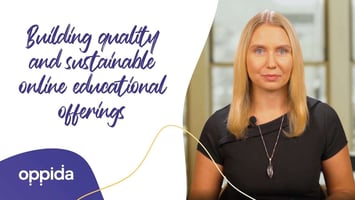Digital education continues to revolutionise teaching and learning—both in and out of traditional...
Improve retention in online courses with this learner-first strategy (most teams still miss it)
Imagine this… You spend 8 months nurturing a student lead for your online courses or programs. You email them every month. You talk on the phone every 2 months. You see their name on your ‘lead’ list for what feels like forever. You answer all their questions. You provide them with a sample of your online courses. You invite them to an information night. Then finally, one cold winter’s day, the student finally decides to take the plunge and enroll! You jump out of your seat with joy and your colleagues give you a high five. You treat yourself to a fancy coffee and give yourself a pat on the back. However, this is really only the beginning of the Student Experience (SX). From this point on there are so many things that can go wrong which could lead to this student dropping out and all those efforts going to waste. Let's talk retention in online courses!

From our experience at Oppida, the most common mistakes that organizations can make that will impact student retention fall into 3 broad categories:
- Firstly, the product doesn’t fit the sell.
- Secondly, the SX is inconsistent and unprofessional.
- Finally, the quality of the actual online course is low and it doesn’t teach the student anything!
The online courses don’t fit the sell
Just like in any transaction, the student consumer expects to get what they paid for when they purchase online courses. Investing in online education is a big decision for most learners, regardless if its a short course or a full remote degree. If during the sales pitch students are promised certain benefits, experiences, and opportunities, then they will expect these to happen otherwise their retention will be difficult. It sounds pretty obvious but if the sales and marketing team are not engaged with the development and student experience team this can be an easy trap to fall into.
Student: “You said I would be able to visit Google headquarters and meet the CEO?”
Student support officer: “Huh…who told you that?”
Student: “The sales guy last year”.
Student support officer: “I am very sorry. That is really not going to happen. I do know someone who used to work at Google though—she would be happy to chat with you”.

The overall student experience is inconsistent and unprofessional
SX is something that has been increasingly getting attention in higher education as students start to demand a seamless online learning experience. These are the typical steps/stages a student may go through with your organization's sales funnel.
- Enquire
- Investigate & research
- Enroll
- Pay
- Access
- Learn & engage
- Complete or graduate
- Engage as Alumni (possibly)
- Re-invest or promote to others
So, if any one of these steps inspires a red flag for the student about the quality, integrity or professionalism of your organization or institution, they may run or speak unkindly of your brand to others. Even if the learner does decide to stay and put up with it—their good will starts to diminish over time. After all, to a student, every interaction throughout the course is with your brand (not different departments as you may have segmented into) and will impact their retention.
Student: “I received my login details but can’t see anything in the LMS”.
Facilitator: “Oh really. That is strange—let me find out what is happening”.
~4 days later~
Student: “I still can’t access any material. It says I am not authorized. I am worried as I know you said in the induction we have an assessment in week 1”.
Facilitator: “Oh, sorry. Yes, I forgot to ask student support. Will do that now and make sure they call you”.
~3 days later~
Student: “Ok, so they called but it still doesn’t work. I will need an extension for week 1. This is not good enough”.
Facilitator: “Of course. I am sorry”.

It’s a low-quality product that doesn’t engage or teach anything
Unfortunately, online education is no stranger to low-quality. Low-quality typically occurs when the development of an online course is viewed as a cost and not an investment. Other factors for low-quality include when deadlines are unrealistic, teams are under-resourced, and there is a lack of quality assurance or there are large skills gaps. Creating engaging and pedagogically sound online learning experiences that achieve a set of predetermined and considered outcomes can be a complex process. Such a process requires time, strong collaboration, and a multidisciplinary team approach to realize exceptional high-quality online courses, but it is essential to student retention. The expectations of online students are only increasing—especially as we see the tech-savvy millennials become a large customer segment.
Student: “This assignment doesn’t make sense. I can’t see how it links to any of the content we have covered so far. I have had to do hours of research just to understand the question”.
Facilitator: “Ah, yes. I can see what you mean. I have just checked with the person who wrote the course. They informed me the assignment was written by someone else who hadn’t seen the online modules. Sorry, but we can’t do anything about it now. Here are some resources that might help. Good luck”.

Increasing retention requires everyone to be involved
If the aim of the investment in online courses to attract and enroll a student is to be realized, then we must increase retention through quality. To retain students long-term, we need the brand to offer a consistent, professional, and exceptional experience that actually teaches the subject they enrolled to learn. To do this, we need all departments on the same page and working together with the student at the Centre of their efforts.
At Oppida, we understand how hard this can be in reality with budgetary requirements and time restraints. Our team has a wealth of experience to draw from, especially in designing for online courses. Set up a call today to discover how we can help you increase your retention and, therefore, improve the quality and growth of your online offerings.
For more on optimizing your online courses, check out our piece on Migrating to a New Learning Management System.



